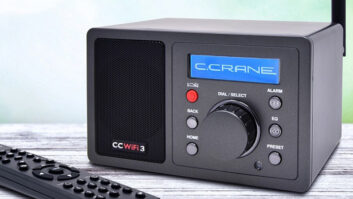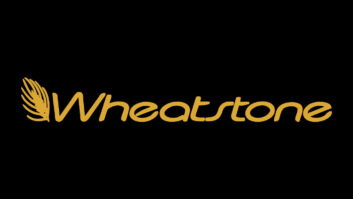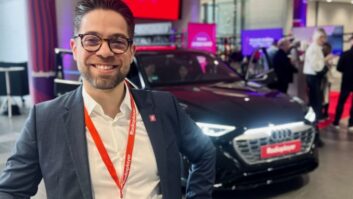GENEVA — The Digital Radio Summit is the flagship event within the European Broadcasting Union’s Digital Radio Week, which also includes the Radio Hack and the RadioDNS Automotive event.
People from the EBU community of public service broadcasters, together with delegates from commercial media groups and equipment manufacturers attended the 2018 edition held at the EBU headquarter in Geneva Feb. 14.

Joseph D’Angelo, senior vice president of broadcast radio at Xperi, speaks to the audience about hybrid radio standards and solutions around the world.
AS GOOD AS IT SOUNDS
Opening the Digital Radio Summit, Ben Poor, EBU’s project manager, welcomed the audience: “Greater connectivity, voice controlled devices, widening multiplatform consumption are all factors that will affect how radio be enjoyed in the future. This also has an effect on cars, a place where radio is and should remain strong.”
He then stressed how broadcasters should work in a closer cooperation with car manufacturers in order to ensure continuous enhancement of the user experience associated with in-car radio listening, because radio has to face the rising competition with the many audio alternatives now available in modern cars.
“Voice control was one of the trendy topics in 2017, but now it’s definitely more visible,” Poor added. “Surveys tell us radio is one of the most popular mediums people listen to on their smart speakers. Let’s do our best to ensure radio becomes more visible and accessible also on these devices.”

Sam Matheny, NAB CTO, emphasized the importance for radio of being part of consumers’ habits, even while they are at home or using their smartphone.
Sam Matheny, NAB CTO, gave an overview on the United States radio distribution scenario, where about 80 percent of radio listening is potentially related to digital radio (including listening to analog stations with an associated digital HD Radio broadcast).
“We have to be part of consumers’ habits while they are at home or they are using their smartphone,” Matheny said. “Because consumers will eventually bring their home and smartphone habits to their car, and in-car listening is a key market for radio.”
He then showcased how Pandora, Spotify, Apple Music are taking full advantage of modern car dashboards’ color displays, through the use of rich and stylish graphics.
“Radio must look as good as it sounds” Matheny added. Authorities in the U.S. are on the move to require a camera to be installed on each car, for safety reasons. “A camera requires a color display, so we have the opportunity to display something on it. Radio has to become more visible in the car,” Matheny concluded.

Patrick Hannon, WorldDAB president, believes DAB+ helps safeguard broadcast radio against competing audio platforms.
DIGITAL DEVELOPMENTS
Patrick Hannon, WorldDAB president, gave the audience an overview on digital radio in Europe. Norway’s switch off is now a fact, while the next country to make a digital switchover will be Switzerland in 2020. Digital listening in United Kingdom recently reached 49.9 percent, and when it exceeds 50 percent authorities will consider the digital switchover.
In Germany the government alliance “Grand Coalition” said they are planning to promote digital radio at a European level. At the end of 2017 French regulators announced a speed-up of the deployment process with the country expecting to soon reach 20 percent of its population with digital radio.
This 20-percent milestone will trigger the mandatory inclusion of digital radio in all receivers sold in France. In Italy, from 2020, a digital tuner will be mandatory in any radio receiver. According to Hannon, DAB+ helps safeguard broadcast radio against competing audio platforms.

Tomas Granryd (left), product manager for digital public products at Sveriges Radio and Ben Poor, project manager at the EBU, during a question and answer session.
Tomas Granryd, product manager for digital public products at public broadcaster Sveriges Radio, highlighted that “a smart speaker is a pure audio product, and for the first time in 20 years a 20 year-old person will be able to buy a pure audio device. It’s a great opportunity: 16 percent of U.S. people aged 18+ have a smart speaker, around 39 million people, and 71 percent of them is listening to more audio since they bought the smart speaker.”
To stay close to this promising market segment, Sveriges Radio formed the PlayX team in 2017, with the goal of developing skills for smart speakers, even if no support for Swedish language is available yet.
RadioDNS Hybrid Radio Seminar
EBU Digital Radio Week hosted the 12th RadioDNS General Assembly, the Hybrid Radio seminar and the automotive workshop. During these events WorldDAB and RadioDNS showcased the recently issued set of guidelines for broadcasters with services on FM and DAB to supply and update brand logos, and guidance to automotive manufacturers for downloading and display of these logos.
Nick Piggott, RadioDNS project director, emphasized the need for broadcasters and car/multimedia system manufacturers to enter into a fair agreement dealing with licensing and right about the use of broadcasters’ logos. Some people from the audience questioned whether asking the automotive industry to enter into an agreement with each broadcaster operating in their cars’ potential markets would be the “killer application” to push radio out of the car dashboards.
Christian Winter (left) and Florian Hoffmann, radio development engineers at Audi, demonstrated the hybrid features of the new Audi A8’s infotainment system at the RadioDNS Automotive Forum, part of the EBU Digital Radio Week.

Christian Winter and Florian Hoffmann, radio development engineers at Audi, demonstrated the hybrid features of the new Audi A8’s infotainment system. According to the manufacturer, the Audi system is able to deliver a “seamless radio experience” by automatically switching between the analog FM, digital DAB+ and IP broadcasts of the same station.
“We are the first automobile company to use Radio DNS,” Winter said. “RadioDNS is the connection between the radio broadcasting world and the online world. Additionally, we fetch further transmitted data from our partner radioplayer.”
“Exploring music is a key factor for listening to radio. Remembering the title of a song in order to listen to it again would be great, but even better would be the ability to directly save that song. So the PlayX Team developed a new skill,” Granryd explained. “When you ask Alexa the title of the song currently playing, Alexa answers the question, then asks the listener if they would like to add the song to their Spotify playlist.” Granryd ran a brief demo of this functionality.
2030
The EBU carried out a survey asking delegates to give their forecast for the radio market in 2030. A majority of those who responded said that in 2030 they believe devices to have a voice-controlled interface. Others expect radio to continue as a core component of in-car entertainment, radio across Europe to be totally digital, hybrid radio to be available on every radio device sold, and both linear and on-demand radio to still be the medium with the highest reach.
The ideas that in year 2030 most radio consumption will be online and on demand, that people will still buy stand-alone devices and that personalization will have replaced linear radio received mixed views.
The highest level of disagreement among those surveyed was regarding the proposition that in year 2030 Amazon, Google, and other tech giants will have dictated radio’s fate, and that music will have disappeared from radio and only devoted to speech.
Davide Moro reports on the industry for Radio World International from Bergamo, Italy







